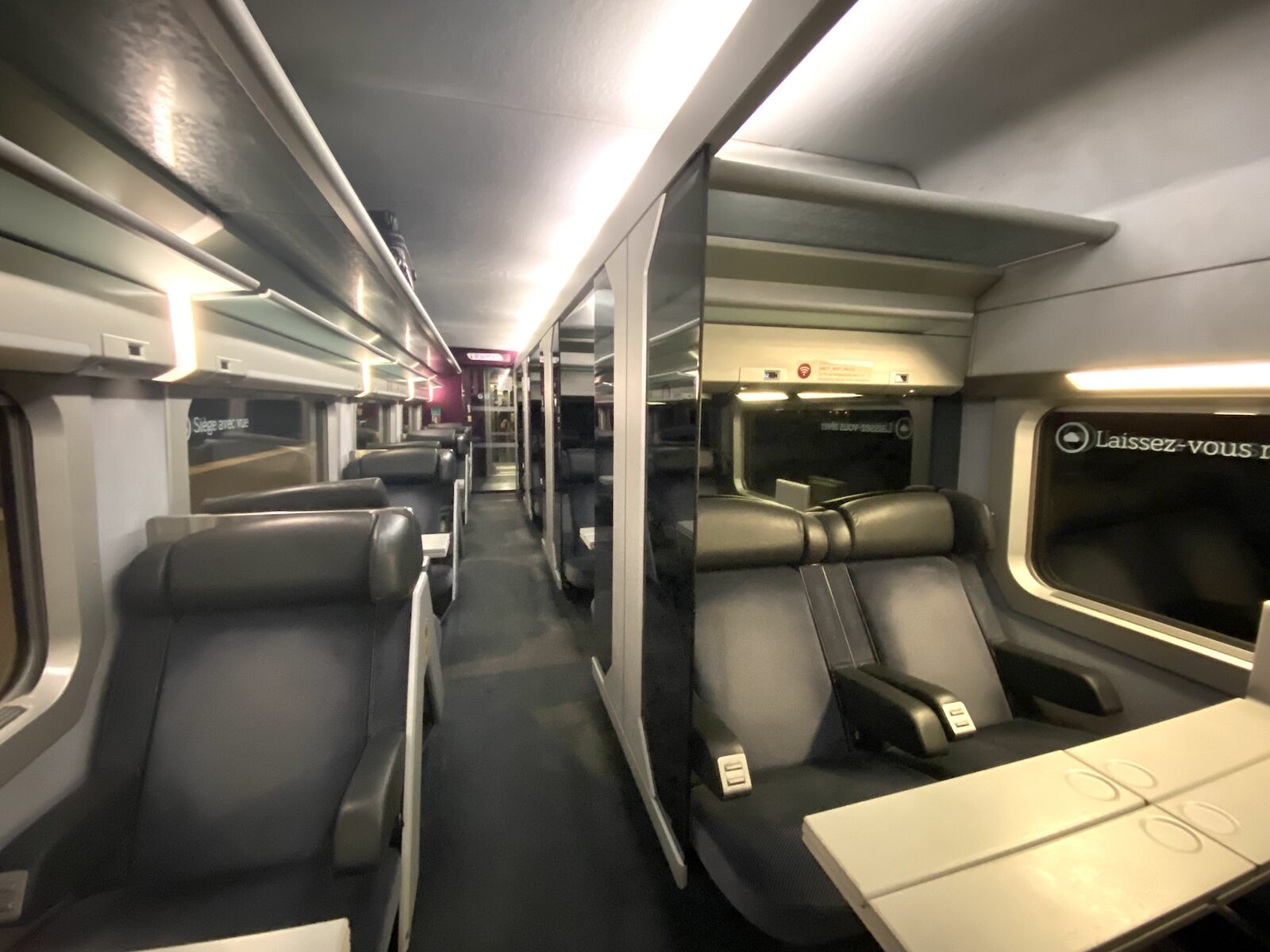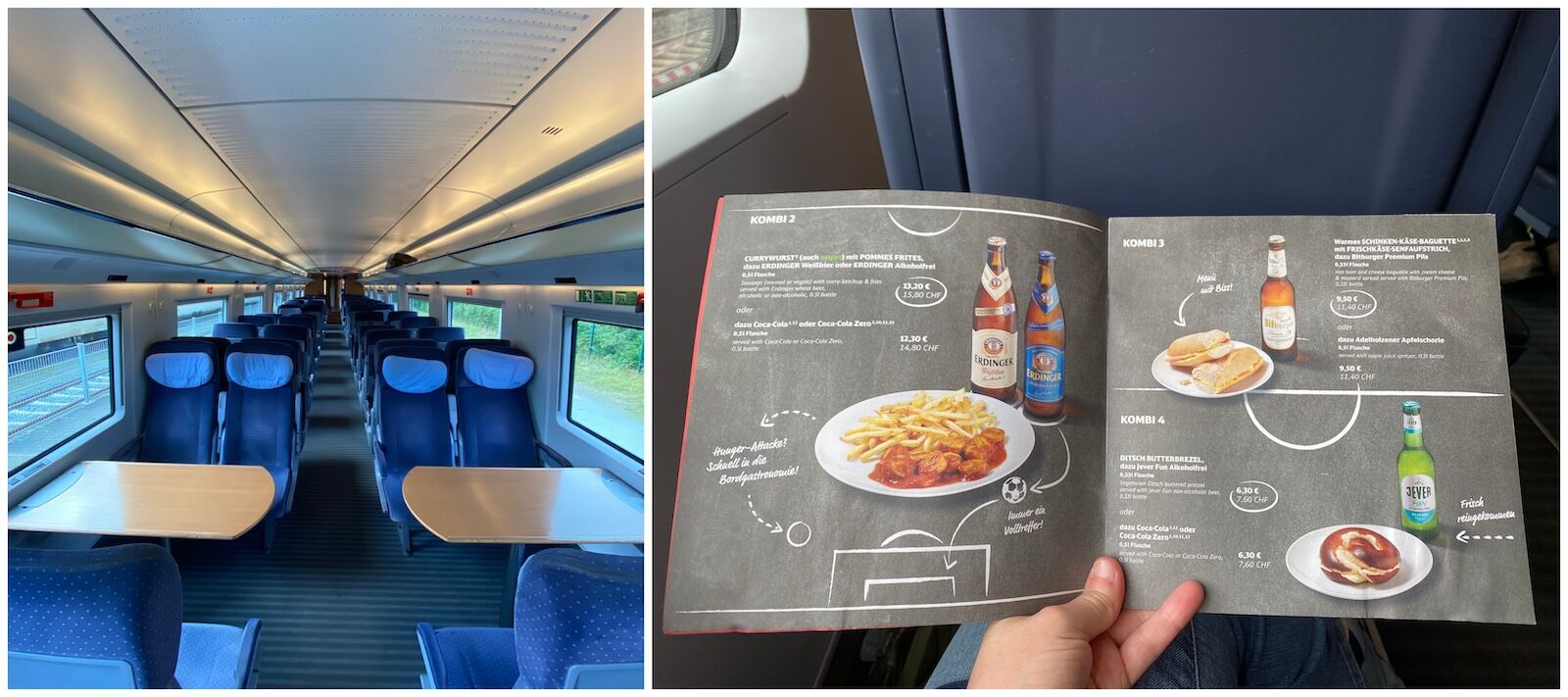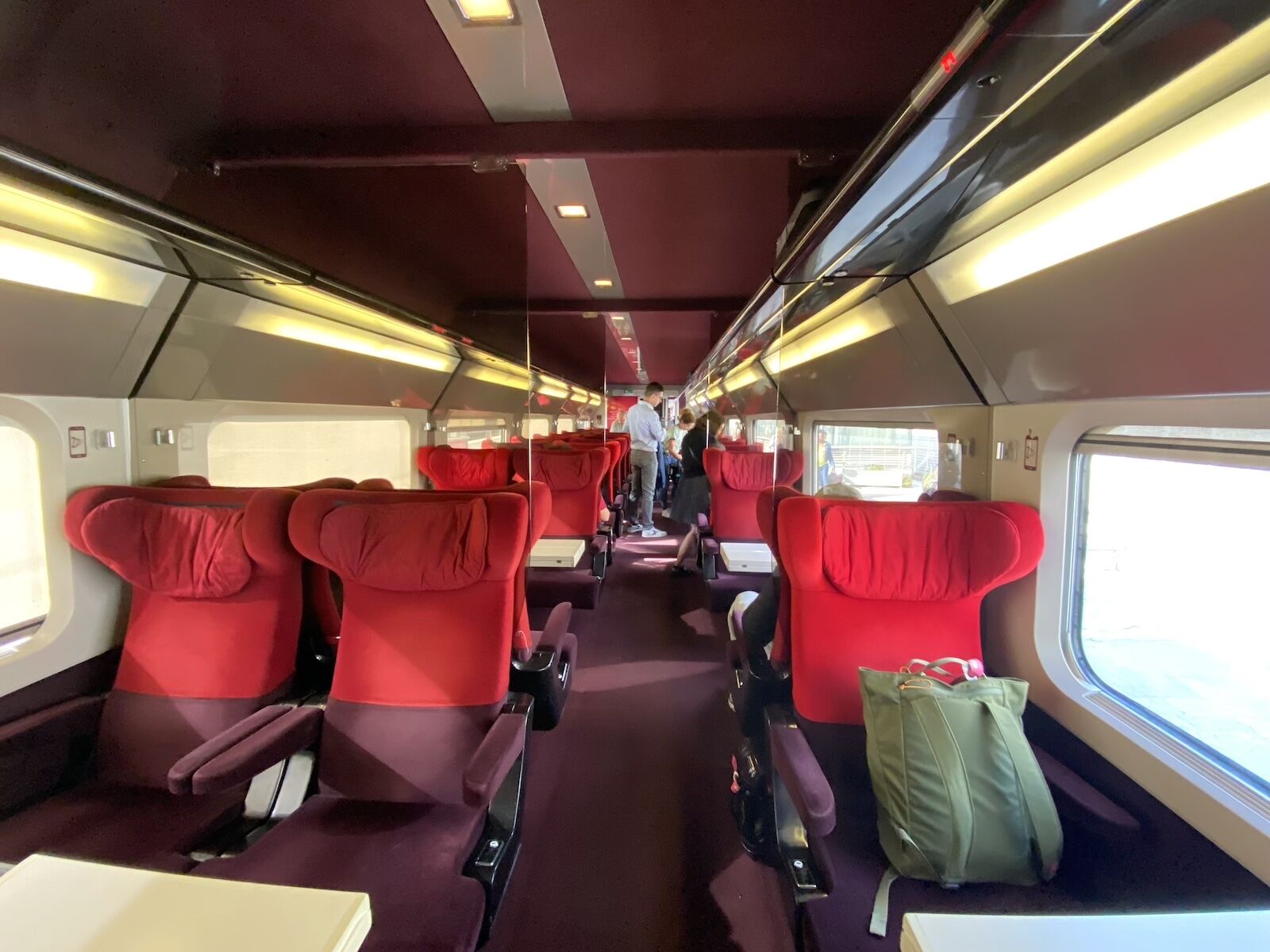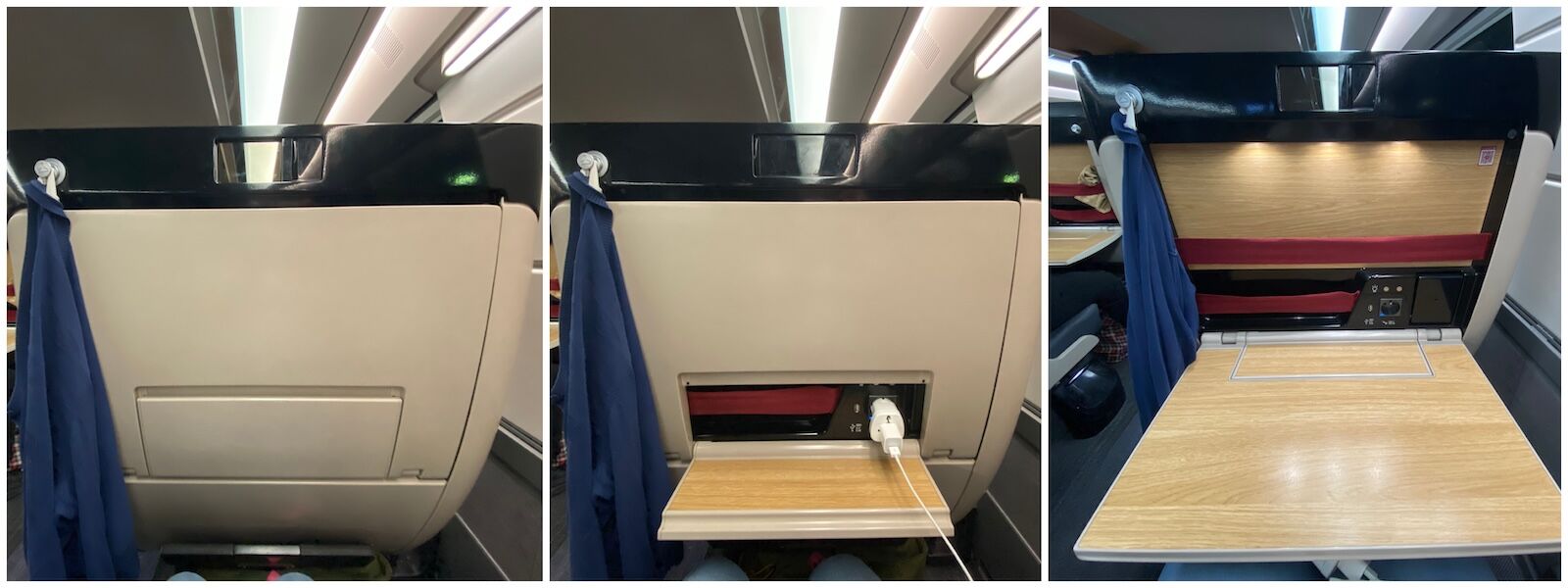If you’re worried about climate change and vow to do as much as you can to slow down its terrible consequences, you must put your money where your mouth is. For travelers, that means flying less. While practical, affordable, and time-effective alternatives to air travel aren’t always available in the US, in Europe, they abound. That’s because the rail system throughout the continent is a vast, well-oiled machine.


What It’s Like to Ride First Class Trains From France to Germany, and Back
Recently, I traveled from the town of St. Nazaire in Western France to the island of Rügen in the very northeast of Germany, and back. While I could have flown most of the way, I am dedicated to my climate change action pledge and therefore opted to ride the rails and use public transports for the entirety of my trip. The journey to and from Germany was long, but very comfortable, and much more scenic than I anticipated. I was lucky enough to travel in first class throughout, which although cost more, made a big difference when traveling such a long way.
My itinerary and schedule traveling by train across France and Germany
Unsurprisingly for such a lengthy journey, my itinerary (which I created via Rail Europe) consisted of many segments, some with very tight, anxiety-inducing connections. That said, despite some delays and the pre-Olympic Games sabotage on the French railway lines the day before my return trip, I caught every single one of my trains.
The outbound journey from France to Germany
The outbound journey took around 16 hours in total and involved three high-speed trains, two regional trains, and one metro ride:
- TGV from St. Nazaire, France, to Paris Montparnasse, France (two hours and 44 minutes)
- Metro line four from Paris Montparnasse, France, to Paris Gare du Nord, France (20 minutes)
- Eurostar from Paris Gare du Nord, France, to Cologne Hauptbahnhof, Germany (three hours and 20 minutes)
- ICE from Cologne Hauptbahnhof, Germany, to Berlin Hauptbahnhof, Germany (four hours and 28 minutes)
- Regional train from Berlin Hauptbahnhof, Germany, to Greifswald, Germany (two hours and 47 minutes)
Because I wanted to break up the trip with a visit of beautiful Greifswald, I took this last train was two days later:
- Regional train from Greifswald, Germany, to Binz, Germany (one hour and 36 minutes)
The inbound journey from Germany to France
The inbound journey consisted of four high-speed trains, and one metro ride. The trip from Hamburg, Germany, to St. Nazaire, France, took around 15.5 hours:
- ICE from Binz, Germany, to Hamburg Hauptbahnhof, Germany (three hours and 53 minutes)
I continued on my journey after a day of touring Hamburg with professional guide Thomas Kaiser and after spending the night in the city’s newly opened bunker hotel: the REVERB by Hard Rock.
- ICE from Hamburg Hauptbahnhof, Germany, to Mannheim, Germany (four hours and 57 minutes)
- TGV from Mannheim, Germany, to Paris Gare de l’Est, France (three hours and 10 minutes)
- Metro line four from Paris Gare de l’Est, France, to Paris Montparnasse, France (20 minutes)
- Paris Montparnasse, France, to St. Nazaire, France (meant to take three hours but took five hours because of the aforementioned sabotage)
How much did this long European train trip cost?
All my train tickets for this rail journey were purchased on June 17, 2024, i.e. around one month before my departure on July 21. Booking earlier than that, possibly three months in advance, when the bookings open, guarantees much better rates.
Price of the outbound journey
- TGV from St. Nazaire, France, to Paris Montparnasse, France: €63 / $69.22
- Metro line four from Paris Montparnasse, France, to Paris Gare du Nord, France: €4 / $4.39
- Eurostar from Paris Gare du Nord, France, to Cologne Hauptbahnhof, Germany: €111 / $121.96
- ICE from Cologne, Germany, to Berlin Hauptbahnhof, Germany: €75.49 / $82.94, including the next ride to Greifswald
- Regional train from Berlin Hauptbahnhof, Germany, to Greifswald, Germany
- Regional train from Greifswald, Germany, to Binz, Germany: €24.30 / $26.70
Total: €277.79 / $305.21
Price of the inbound journey
- ICE from Binz, Germany, to Hamburg Hauptbahnhof, Germany: €40.19 / $44.16
- ICE from Hamburg Hauptbahnhof, Germany, to Mannheim, Germany: €179.40 / $197.11, including the next ride to Paris
- TGV from Mannheim, Germany, to Paris Gare de l’Est, France
- Metro line four from Paris Gare de l’Est, France, to Paris Montparnasse, France: €4 / $4.39
- Paris Montparnasse, France, to St. Nazaire, France: €95 / $104.38
Total: €318.59 / $350.04
How to save more on your train trips
There are several ways to make this trip a lot cheaper. First, you can opt to travel in second class instead of first class, like I did. While traveling in first class can be very affordable if you book early, the longer you wait to make a reservation, the higher the price. And in my case, I certainly waited too long. Second, you can save a lot of money by purchasing an Eurail/Interrail Pass. In this particular case, I could have bought an Eurail/interrail Global Pass for four days of travel within one month for just $308. It would have covered all the trains I took during the time period I needed, but not the seat reservations for the high-speed trains. Those would have cost a little extra, but I would still have saved a lot of money.
ICE, Eurostar, TGV: Which one is the best?
It’s fair to say that I’ve thoroughly tested enough high-speed trains in this epic rail journey (and during my previous experience riding the rails in Europe) to be able to rate them.

Brand new French TGV. Photo: Morgane Croissant
In term of comfort, cleanliness, and atmosphere, it’s hard to beat France’s TGV. The first-class cars offer very wide, comfortable, fabric-upholstered seats, with lots of legroom, large tray tables, and plugs, including USB ones. Single seats with no neighbors are available in all first-class cars and are bookable in advance. It’s also extremely quiet in first class, allowing you to work, read, or sleep for hours on end without being disturbed. The TGV has two cafés on board and the food and drinks on offer are suitable for various dietary needs and affordable. The cafés staff are always very polite and helpful, making the experience even nicer. Passengers who want to save time can purchase Parisian metro tickets in the TGV cafés. The Wi-Fi on board is relatively fast and reliable.

Inside the German ICE in first class. Photos: Morgane Croissant
First class on board the German ICE, while also comfortable, is a lot less quiet than in the TGV. There were numerous families with small children sharing my car on all my ICE trips and the noise level was quite high. Single seats are available and bookable, which you should absolutely go for, but know that they are less comfortable than the TGV’s. Also, the tray tables are smaller, and there are no USB plugs. The great advantage of riding the ICE in first class is that attendants come through the car to take your order if you wish to eat or drink anything. A menu is at your disposal in the seat pocket, offering a variety of food and drinks for an affordable price. Also, every first-class passenger gets a little complimentary cookie from one of the attendants during the journey, which is a nice touch. The Wi-Fi on board was fast and dependable, allowing me to work and even stream a few episodes of Seinfeld.

Inside the Eurostar (formerly Thalys) in first class. Photo: Morgane Croissant
The Eurostar (formerly Thalys), while fine, was the least enjoyable ride of them all. There are three classes of service on board the Eurostar: Standard, Comfort, and Premium, and I was riding with a Comfort ticket in the first-class car. While very comfortable, the seats and carpet were not very clean and the cars could have done with a refresh. The legroom is decent, however, and there are regular plugs at every seat. There is a café on board with various snacks and drinks on offer. Premium passengers get a menu and a meal served at their seat. The Wi-Fi on board worked throughout the journey.

The last high-speed train of the trip, a very recent TGV, with its great tray table. Photos: Morgane Croissant
Note that the newness of the rolling stock makes a big difference in how good an experience you have on board all of these trains. Unless you do an awful lot of research, you never know if the train you’re booked on will be brand new, recently redecorated, or 15 years old. Every single TGV I rode on during this trip was different, some were duplex, some were single-storeyed, some were new, and other had a few years of use behind them.
The most scenic ride I ever took

Photo: FrankFotoFilm/Shutterstock
In the past 20 years, I have criss-crossed Europe by train. I have even traveled from Western France all the way to St. Petersburg, Russia, in an incredibly rural three-day journey. But never have I had been treated to more beautiful scenery than on my no-frills regional train ride from Berlin to Greifswald. For nearly three hours, we chugged across the open countryside of Northern Germany where the stations are tiny and old-fashioned, and the wildlife abounds. From my window seat, I spotted dozens of deer, storks, and rabbits, among others, all going about their business in the fields, undisturbed. The many wind turbines present in the region added an air of peacefulness to the scenery, and the large numbers of bicycles on the nearby trails made it all the more quaint. I doubt the commuters from Berlin pay attention to what’s going on outside any longer, but for me, this is one for the books.
How to prepare for a long train trip
There are few ways to make a long train trip less stressful, more enjoyable, and more affordable:
- If you’re traveling alone and want peace and quiet, book a single seat in advance.
- In general, if you can, avoid connections of less than 30 minutes. Delays happen frequently and can ruin the best laid plans.
- Review your itinerary prior to departure and look closely at the dates, times, destinations, and how long you have for each connection.
- If a connection is tight, ask the train attendant the platform number for your next train so you can make a beeline for it as soon as the train stops. Also, always be ready by the exit door with all your belongings so you can be the first passenger out and run to catch your next train.
- Alway sit at your assigned seat rather than at a random one. It will prevent a lot of shuffling around in a tight space.
- Bring some water and food with you. That way you won’t have to spend your hard-earned money at the onboard cafés or at the train stations, and you’ll have something to snack on when hunger strikes, no matter where it happens.
- Make sure to take a book, download some episodes of your favorite series on your phone, and bring headphones. While looking at the scenery out the window is a good way to pass the time, a little manmade entertainment will make the trip go faster.
- Prioritize using the bathroom on board the trains rather than in the train stations. It’s easier when your luggage is safely tucked away.
- Always tag your luggage with your name and phone number.
- Take your charger with you and make sure your phone is charged at all times, especially if that’s where you keep your train tickets. You can print them out for safety, too. Attendants will require to see them on every leg of your journey.
- Wear comfortable clothes in which you can take a nap. Avoid tight jeans and bulky sweaters. Layers are best as the onboard temperature varies widely from one rail operator to the next, and even from one train to another.